
The University of Saskatchewan is a Canadian public research university, founded on March 19, 1907, and located on the east side of the South Saskatchewan River in Saskatoon, Saskatchewan, Canada. An "Act to establish and incorporate a University for the Province of Saskatchewan" was passed by the provincial legislature in 1907. It established the provincial university on March 19, 1907 "for the purpose of providing facilities for higher education in all its branches and enabling all persons without regard to race, creed or religion to take the fullest advantage". The University of Saskatchewan is the largest education institution in the Canadian province of Saskatchewan. The University of Saskatchewan is one of Canada's top research universities and is a member of the U15 Group of Canadian Research Universities.

Saskatoon Public Schools (SPS) or Saskatoon S.D. No. 13 is the largest school division in Saskatchewan serving approximately 24,000 students.

The University of Regina is a public research university located in Regina, Saskatchewan, Canada. Founded in 1911 as a private denominational high school of the Methodist Church of Canada, it began an association with the University of Saskatchewan as a junior college in 1925, and was disaffiliated by the Church and fully ceded to the university in 1934; in 1961 it attained degree-granting status as the Regina Campus of the University of Saskatchewan. It became an autonomous university in 1974. The University of Regina has an enrolment of over 15,000 full and part-time students. The university's student newspaper, The Carillon, is a member of CUP.

Sutherland is a mostly residential neighbourhood located in east-central Saskatoon, Saskatchewan, Canada. It is an older suburban subdivision, composed of a near-even mix of single-family detached houses and multiple-unit apartment and semi-detached dwellings. As of 2006, the area was home to 5,206 residents. The neighbourhood is a middle-income area, with an average family income of $51,857, an average dwelling value of $204,213 and a home ownership rate of 43.8%. According to MLS data, the average sale price of a home as of 2013 was $288,651. Sutherland was administered as a separate town outside of Saskatoon before being annexed by the city in 1956.

Nutana is a primarily residential neighbourhood located near the centre of Saskatoon, Saskatchewan, Canada. It includes the business district of Broadway Avenue. It comprises a nearly even mixture of low-density, single detached dwellings and apartment-style multiple unit dwellings. As of 2009, the area is home to 6,261 residents. The neighbourhood is considered a middle to upper-income area, with an average family income of $67,657, an average dwelling value of $206,830 and a home ownership rate of 51.3%. First established in 1883, Nutana was the original settlement of what now makes up the city of Saskatoon.

Varsity View is a mostly residential neighbourhood located near central Saskatoon, Saskatchewan, Canada. It is immediately south of the University of Saskatchewan campus. It is an older suburban subdivision, comprising a mixture of low-density, single detached dwellings, detached duplexes and apartment-style units. As of 2007, the area is home to 3,611 residents. The neighbourhood is considered a middle-income area, with an average family income of $50,587, an average dwelling value of $284,710 and a home ownership rate of 38.7%. Its proximity to the university gives this area its relatively high student population, almost 25% in 2005.
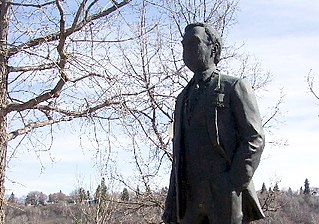
Canada is a constitutional monarchy, and connections to the Canadian Crown in Saskatoon, the most populous city in the Canadian province of Saskatchewan, are visible in visits from the Sovereign of Canada, the Canadian Royal Family and vice-regal representatives, and also in the prominence of names and symbols in civic traditions. The Crown's image appears in the centrepiece portrait at Saskatoon City Council chamber and also in the badges of Saskatoon Police Service officers. On one of several visits to Saskatoon, Queen Elizabeth II said "Constitutional Monarchy has always placed the emphasis on people in community – as it were, a national family with the Sovereign as its head." Saskatoon's manifold connections include more than a dozen royal visits, frequent vice-regal visitors, namesakes for schools, streets and neighbourhoods, and the regular inclusion of its own namesake, the saskatoon berry, on menus for royal and vice-regal functions. Canada's 2008 definitive postage stamp features a photograph of Queen Elizabeth II taken in Saskatoon.

The Central Business District is one of seven development districts in Saskatoon, Saskatchewan, Canada. The central business district is Ward 6 of a Mayor-Council government represented by councillor Cynthia Block. Formerly called West Saskatoon, this area arose when the steam engines built their pumping stations on the lower west bank of the South Saskatchewan River. Retail enterprises sprang up around the newly created train station and rail yards. The city of Saskatoon's Central Business District has shopping malls and boutiques.
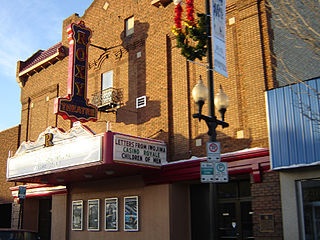
Riversdale is one of the oldest neighbourhoods in Saskatoon, Saskatchewan, Canada, located near the downtown area. It includes the business district of 20th Street. It consists mostly of low-density, single detached dwellings. As of 2021, the area was home to 2,534 residents.

Caswell Hill is a district in the city of Saskatoon, Saskatchewan, Canada. It derives its name from an early homesteader Robert Caswell one of the Temperance Colonists of 1883. It is an area of beautiful character homes first built ca. 1905, tiny war-time houses, and newer houses. Caswell is a thriving and diverse community nestled between two economic areas, the downtown core, and the stores lining 33rd Street West.
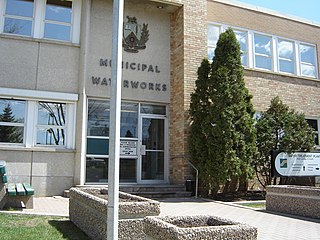
King George is an older inner city neighbourhood located near the centre of Saskatoon, Saskatchewan, Canada. It consists mostly of low-density, single detached dwellings. As of 2011, the area is home to 1,902 residents. The neighbourhood is considered a lower-income area with an average family income of $47,581, an average dwelling value of $146,941 and a home ownership rate of 69.1%.

Queen Elizabeth is a mostly residential neighbourhood located in south-central Saskatoon, Saskatchewan, Canada. It is a suburban subdivision, consisting mostly of low-density, single detached dwellings. As of 2007, the area is home to 2,491 residents. The neighbourhood is considered a middle-income area, with an average family income of $61,904, an average dwelling value of $280,970 and a home ownership rate of 66.9%.

Adelaide/Churchill is a mostly residential neighbourhood located in south-central Saskatoon, Saskatchewan, Canada. It is a suburban subdivision, consisting mostly of low-density, single detached dwellings. As of 2009, the area is home to 3,445 residents. The neighbourhood is considered a middle-income area, with an average family income of $78,438, an average dwelling value of $287,976 and a home ownership rate of 90.3%.
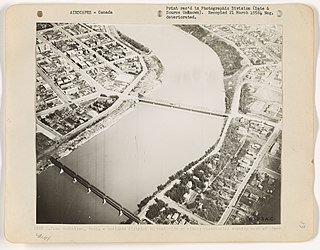
The history of Saskatoon began with the first permanent non-indigenous settlement of Saskatoon, Saskatchewan, Canada, in 1883 when Toronto Methodists, wanting to escape the liquor trade in that city, decided to set up a "dry" community in the rapidly growing prairie region. As of 1882 this area was a part of the provisional district named Saskatchewan, North-West Territories (NWT). Their organization, the Temperance Colonization Society, first examined this area in 1882 and found that it would make an excellent location to found their community based on the ideals of the temperance movement; Saskatoon traditionally considers 1882 its founding year and thus marked its centennial in 1982. The settlers, led by John Neilson Lake, arrived on the site of what is now Saskatoon by traveling by railway from Ontario to Moose Jaw, Assiniboia, NWT, and then completing the final leg via horse-drawn cart. The plan for the Temperance Colony soon failed as the group was unable to obtain a large block of land within the community. Nonetheless, John Lake is commonly identified as the founder of Saskatoon; a public school, a park and two streets are named after him.
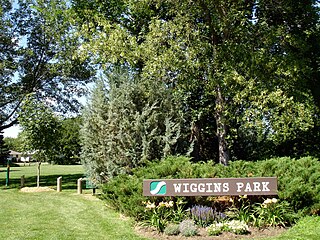
Holliston is a primarily residential neighbourhood located in the southeast part of Saskatoon, Saskatchewan, Canada. It includes part of the 8th Street business district. Just over half of its dwellings are single detached houses, with a sizeable minority of duplex or apartment-style multiple unit dwellings. As of 2007, the area is home to 3,412 residents. The neighbourhood is considered a middle-income area, with an average family income of $51,674, and a home ownership rate of 62.8%.
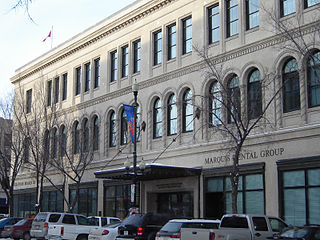
The Eaton's Building is a landmark building located in downtown Saskatoon, Saskatchewan, Canada. Formerly serving as an Eaton's department store, the building is currently occupied by the Saskatoon Board of Education.

University of Saskatchewan has over 200 academic programs on its Saskatoon, Saskatchewan campus, and is internationally known for its teaching and research. The on-campus synchrotron Canadian Light Source makes it the only Canadian institution for such nuclear and biotechnology research. Canadian Light Source nuclear research facility provides research and analysis of the internal structures of advanced materials and biological samples. The College of Arts and Science is the largest of the U of S and comprises five separate health science fields in addition to numerous other programs in the Arts, Social Sciences, Humanities, and Natural Sciences. The Department of Computer Science as well as the College of Engineering are ranked highly within their fields. The founding college, the College of Agriculture, is still providing agricultural breakthroughs which are utilized worldwide.

Rugby Chapel is a municipal historic site which is part of the University of Saskatchewan. The U of S is the largest education institution in the Canadian province of Saskatchewan. The University of Saskatchewan location next to the South Saskatchewan River was across from the city centre of Saskatoon. In 1879, the Rt. Rev. John McLean started a schooling system in Prince Albert which was renamed the University of Saskatchewan in 1883. In 1909, when the University of Saskatchewan was established in Saskatoon, Emmanuel College moved its college buildings to Saskatoon. The Institute for stained glass in Canada has documented the stained glass at Rugby Chapel.

U of S Lands South Management Area is an area of and located in east-central Saskatoon, Saskatchewan, Canada. It is a categorized as a management area, as it lacks the residential, industrial or future development characteristics present in most neighbourhoods. The area is home to 1,103 residents living in residences belonging to the University of Saskatchewan. The neighbourhood is considered a lower-income area, with an average family income of $36,760, an average dwelling value of $221,222 and a home ownership rate of 0.2%, though this is, of course, due to residents being primarily students renting accommodation from the university.

The Saskatoon Teachers' College, originally called the Saskatoon Normal School, was a facility in Saskatoon, Saskatchewan, Canada for training teachers. The school occupied temporary premises at first, then moved to a handsome brick and stone building on Avenue A North in 1922. It was administered by the provincial department of education. In 1964 it was merged into the College of Education of the University of Saskatchewan, and became the Avenue A Campus.





















